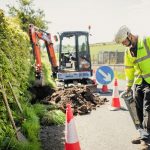Ofcom Consult on UK Rural 5G Mobile Coverage Obligation at 700MHz
The UK telecoms regulator has today launched a new consultation, which seeks to establish what sort of future 4G or 5G based coverage obligation will be attached to the 700MHz band of radio spectrum for mobile network operators (due to be auctioned off during late 2019).
At present Three UK, O2, Vodafone and EE (BT) have already agreed with the UK Government an obligation, which meant mobile phone calls could be made in 90% of the country’s landmass by the end of 2017, using measures of mobile coverage in place at the time. Separately, Ofcom required O2 to provide 4G mobile data coverage to 98% of premises across the UK by the end of 2017 (800MHz band).
However there have long been calls for the coverage obligation to be improved and 700MHz represents the perfect opportunity. Existing Digital Terrestrial TV (DTTV) services are currently in the process of being moved out of this band and pushed into 600MHz. This will then enable the old band to be harnessed for use by future ultrafast Mobile Broadband services via 5G technology.
Advertisement
Using 700MHz (694-790MHz) for Mobile Broadband will allow Mobile Network Operators (MNO) to cover a wider area (plus better indoor coverage) and for less cost, although the data speeds at that frequency won’t be quite as fast (i.e. assuming Ofcom makes less spectrum available at lower frequencies) but they may still improve thanks to the greater potential for Carrier Aggregation (harnessing several different bands at once).
The regulator’s new consultation on this subject actually proposes to establish three new obligations for the 700MHz band.
The Proposed Obligations for 700MHz
* One obligation focused on improved coverage of premises (and their immediate surrounds) in areas where there is currently no indoor coverage from any operator (the ‘premises obligation’):
An operator acquiring the licence carrying this obligation must provide new indoor coverage to 60% of those premises in rural areas that are unserved by any operator at the time of the award. As part of this obligation, we propose that at least 60% of premises without service in each Nation must receive a service.
* Two coverage obligations focused on providing increased geographic coverage in rural areas (the ‘geographic obligations’):
Operators acquiring the licences carrying these obligations must provide good coverage across at least 92% of the total UK landmass. We expect this would equate to more than 90% of the rural landmass. As part of this obligation, we propose that a specific target for coverage in each Nation must be met. We describe and explain the geographic coverage targets for the Nations below.
The regulator states that these obligations should be met at “levels of quality that provide consumers with the kind of experience they expect today“, which they believe must include reliable voice calls and a high probability of access to “at least” 2Mbps data speeds.
“In practice, this implies that a mobile operator is required to deliver a 4G signal strength of – 105 dBm to achieve outdoor geographic coverage, and a 10 dB higher signal strength for the premises obligation (to provide a similar good experience indoors). We expect operators could meet these obligations by providing a mobile service at these quality levels from any frequency band,” said Ofcom.
Advertisement
By comparison and based on information operators have shared with Ofcom, the regulator predicts that an “average mobile operator” is likely to cover around 80% of the UK’s landmass by the end of 2018. Expanding geographic coverage significantly beyond this would require operators to build further new base stations.
Ofcom Statement
We have undertaken a high-level modelling that suggests it would cost no more than £300m for an operator to increase geographic coverage to at least 89-90% by building 500-700 new base stations and operating them for 20 years.
However, there are a number of reasons why we consider that, given our objective to improve mobile coverage for consumers, 89-90% would be too conservative a target to set for the geographic coverage obligation:
a) Firstly, Government is currently in the process of building more than 250 base stations to extend the Emergency Services’ communication network, and these sites will be built in a way that would allow operators to use these sites in the future.
This could result in much lower capital costs to access coverage from these sites (in the order of tens of thousands of pounds, as opposed to hundreds of thousands). We believe a material proportion of these sites could be suitable for expanding geographic coverage. Therefore, the availability of these sites could significantly reduce the costs of expanding coverage;
b) Secondly, it is reasonable to assume that these new sites will deliver some incremental benefits to operators and their customers, so the net cost of expanding coverage may be less than we have set out above;
c) Thirdly, we believe that the operators’ rollout is likely to continue beyond 2018 absent a coverage obligation. Even though we expect this rollout to be quite limited in terms of rural coverage, it suggests 80% is a conservative baseline from which to work;
d) Finally, commercial sharing agreements may enable operators to expand coverage with lower net costs per operator than our conservative assumptions suggest.
In conclusion, Ofcom consider that the above factors are likely to allow the operators to deliver at least a further 2-3% coverage within the indicative £300m envelope. “We therefore think that 92% is an appropriate target“, said the regulator. We should also point out that EE’s geographic (landmass) 4G network coverage of the United Kingdom has already reached about 90% and they aim to cover 95% by the end of December 2020.
However it’s worth remembering that building new mobile infrastructure in rural areas is far from easy. The Government’s last attempt via the £150m Mobile Infrastructure Project (MIP) became bogged down by a mix of problems, from delays in getting planning permission (some communities protested), to challenges with securing wayleave agreements via many different land owners and the difficulty of confirming where “not spots” actually existed (mobile coverage is variable).
Not to mention the inherent problem with finding a three phase power supply or high capacity fibre optic backhaul, which are needed to help support 5G, when in the middle of nowhere. Suffice to say if it was only a matter of cost then the challenge would be much less significant.
Advertisement
In the meantime we don’t anticipate the commercial rollout of 5G to begin in the UK until 2020. The closing date for responses to Ofcom’s consultation is 4th May 2018. The regulator has also launched another document that summarises their plan for supporting 5G (here), although we’ve covered a lot of its core points before.
UPDATE 2:42pm
The CLA landowners association for England and Wales has commented.
Tim Breitmeyer, CLA President, said:
“Mobile coverage in rural areas has suffered from years of underinvestment. The 700mhz spectrum has major potential for increasing the reach of mobile coverage in rural areas but strict conditions in the licence agreements are crucial to ensuring it delivers.
We want to see stringent conditions placed on mobile operators with tough penalties as part of tenders for the auction. We will be pressing Ofcom to ensure that any conditions put in place mean that rural businesses have the same access to 4G services which are enjoyed in towns and cities.”
Mark is a professional technology writer, IT consultant and computer engineer from Dorset (England), he also founded ISPreview in 1999 and enjoys analysing the latest telecoms and broadband developments. Find me on X (Twitter), Mastodon, Facebook, BlueSky, Threads.net and Linkedin.
« Surprise as ISP Virgin Media UK Halt 1Gbps Papworth FTTH Trial
Sky UK Training Programme Hunts for 1000 Female Engineers »
















































Comments are closed